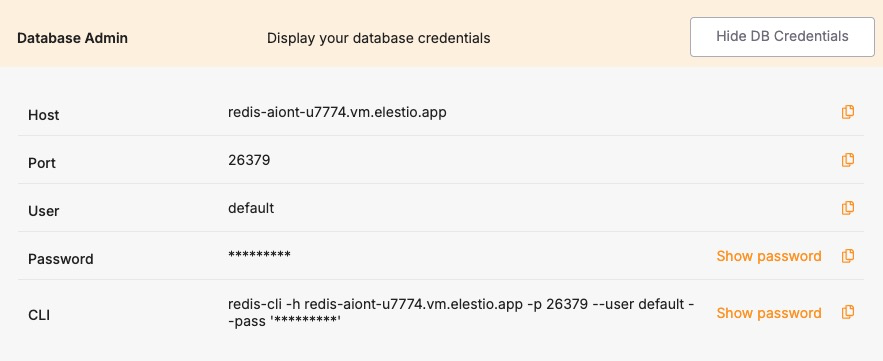Database Migration Services for Redis
Elestio provides a streamlined and reliable approach for migrating Redis instances from various environments such as on-premises servers, self-managed cloud deployments, or other managed services into its fully managed Redis platform. This migration process is designed to ensure data consistency, minimize downtime, and simplify the operational complexity of managing Redis infrastructure.
Key Steps in Migrating to Elestio
Pre-Migration Preparation
Before initiating your Redis migration, proper preparation is essential to ensure a seamless and error-free transition:
- Create an Elestio Account: Sign up on the Elestio platform to access its suite of managed services. This account will serve as the central hub for provisioning and managing your Redis instance.
- Deploy the Target Redis Service: Create a new Redis service on Elestio to act as the migration destination. Make sure the version matches your current Redis setup to avoid compatibility issues. Review Elestio’s Redis documentation for details on supported features, such as persistence modes (AOF, RDB), module support, and cluster configurations.
Initiating the Migration Process
With the target environment ready, proceed with the Redis migration using the Elestio migration interface:
- Access the Migration Tool: Navigate to your Redis service overview on the Elestio dashboard. Select the “Migrate Database” option to initiate the guided migration workflow.
- Configure Migration Settings: A prompt will appear to confirm that the target Redis instance has sufficient memory and disk capacity to receive the source data. Once verified, click “Get started” to begin.
- Validate Source Redis Connection: Enter the connection details for your existing Redis instance, including:
-
Hostname – IP address or domain of the source Redis server
-
Port – Default Redis port is 6379, but on Elestio it is configured as 26379
-
Password – If your Redis instance is secured with authentication
-
Database Number – (Optional) If using a specific logical database within Redis
-
Click “Run Check” to validate the source connection. This ensures Elestio can securely access and read from your Redis instance. These details are typically available in your current Redis deployment configuration or environment variables.
4. Execute the Migration: If all checks pass successfully, start the migration by selecting “Start migration.” Elestio will begin transferring the in-memory dataset and persistent data (if applicable) into the new environment. Real-time logs and progress indicators will help you monitor the operation, making it easy to identify and resolve any issues promptly.
Post-Migration Validation and Optimization
Once the Redis migration is complete, it’s critical to validate the deployment and ensure the new instance performs optimally:
- Verify Data Consistency: Use redis-cli or Elestio’s integrated tools to confirm that all keys, data types, and values were correctly transferred. Compare key counts and sample data between source and target. If using persistence (RDB or AOF), check the loading behavior on restart to ensure durability.
- Test Application Connectivity: Update application configurations or connection strings to point to the new Redis instance. Verify that all interactions such as caching, pub/sub, or session storage are functioning as expected.
- Optimize Performance: Take advantage of Elestio’s performance features. Monitor memory usage, eviction policies, and throughput in real-time using the platform’s dashboard. Adjust Redis configurations for your workload type and enable auto-scaling if supported.
- Implement Security Best Practices: Secure your new Redis instance by configuring firewall rules, enabling TLS (if applicable), and rotating authentication credentials. Elestio supports access management features that help restrict unauthorized connections and secure data in transit.
- Clean Up and Document: After successful validation, decommission the old Redis environment if no longer needed. Update your internal documentation to reflect the new Redis endpoint, authentication details, and any configuration changes made during migration.
Benefits of Using Elestio for Redis
Migrating Redis to Elestio delivers several operational and strategic benefits:
- Simplified Management: Elestio automates the operational overhead of managing Redis, including monitoring, backups, and software updates. The centralized dashboard provides real-time visibility into performance, key metrics, and system health. Users can modify environment variables, upgrade service tiers, and manage Redis modules without deep DevOps intervention.
- Security: Elestio keeps Redis instances up to date with the latest security patches. It offers built-in mechanisms for securely managing credentials and limits unauthorized access through firewall rules and network isolation. Backup automation ensures data is safe and recoverable.
- Performance: Redis instances on Elestio are tuned for low-latency performance and can handle real-time, high-throughput workloads. The infrastructure supports both standalone and clustered Redis deployments, allowing for optimal performance under load.
- Scalability: Elestio’s Redis services are built to scale with your application. Users can increase memory capacity, CPU allocation, or attach additional storage as demand grows. The platform supports seamless plan upgrades without significant downtime, enabling consistent growth and workload flexibility.

